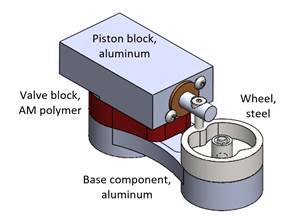Recruitment Machines
Are you involved in a robotics league? These competitions attract and identify young people who could thrive in a manufacturing career.
Share





Here is an irony that’s hard not to love: Contrary to the fear that robots might discourage manufacturing jobs, robots are actually proving to be one of the best resources for drawing young people toward manufacturing careers. I hear this from employers who support competitive robotics programs such as FIRST Robotics or the .
Jergens is an example. The maker of workholding systems routinely supports a team within , northeast Ohio’s branch of the ’s National Robotics League. The league consists of teams of high schoolers working with company coaches to design and build remote-controlled robots that do battle in tournaments. AWT RoboBots is overseen by the Alliance for Working Together, a manufacturers’ group in the region.
Ryan Ponsart, 19, is a past member of Jergens’s AWT RoboBots team whose participation led to the company offering him a job. On the team, he made parts for the robot on Jergens’s equipment under the company’s supervision. It was a great experience, he says, one that solidified and expanded upon what he was learning about machining in his . (If he is not still with Jergens today, that’s only because his other interest is the military. By the time I spoke with him, he had signed on with the Marines.)
Darel Taylor is Jergens’s engineering manager. He coached the RoboBots team the year before Mr. Ponsart joined it. Back then, 11 area companies supported teams. Now, 31 do. He says a company’s motive for sponsoring a team is both community support and self interest, and the two aims blend together. Even if none of the kids on a company’s team turn into employees, the company still benefits from seeing the local manufacturing talent pool expand.
Far away in Calgary, Alberta, Kevin Saruwatari of sees his own company’s recent support of two local FIRST Robotics teams as a similarly promising scouting tactic. Within , he shared a series of posts with other shop owners about his experience with the members of these teams. Like Jergens, he gave the kids hours of access to his shop to make parts for their robots. The team members reached the point where his only role over them was to advise and supervise.
“The program is a good way to meet curious, intelligent, motivated kids,” he says. “My intention is to filter out the really interested kids and offer them ‘build a go-kart’-style projects to try to keep them involved in the off-season.” That is, during the non-robot season.
What is it about robots that succeeds in engaging young people with manufacturing aptitudes? Mr. Taylor has ideas. Part of it is the timeliness—robots are coming into vogue. But he says another part is the type of success that building a robot makes possible. The final system will perform well only if each component is made precisely as designed. In this way, the robot offers a minuature version of the very same challenge and satisfaction that a career in manufacturing will also provide.
Related Content
Workholding Fixtures Save Over 4,500 Hours of Labor Annually
All World Machinery Supply designs each fixture to minimize the number of operations, resulting in reduced handling and idle spindle time.
Read MoreSolve Worker Shortages With ACE Workforce Development
The America’s Cutting Edge (ACE) program is addressing the current shortage in trained and available workers by offering no-cost online and in-person training opportunities in CNC machining and metrology.
Read MoreFinding the Right Tools for a Turning Shop
Xcelicut is a startup shop that has grown thanks to the right machines, cutting tools, grants and other resources.
Read MoreThe Power of Practical Demonstrations and Projects
Practical work has served Bridgerland Technical College both in preparing its current students for manufacturing jobs and in appealing to new generations of potential machinists.
Read MoreRead Next
Machine Shop MBA
Making Chips and 91±¬ÁĎÍř are teaming up for a new podcast series called Machine Shop MBA—designed to help manufacturers measure their success against the industry’s best. Through the lens of the 91±¬ÁĎÍř benchmarking program, the series explores the KPIs that set high-performing shops apart, from machine utilization and first-pass yield to employee engagement and revenue per employee.
Read MoreAMRs Are Moving Into Manufacturing: 4 Considerations for Implementation
AMRs can provide a flexible, easy-to-use automation platform so long as manufacturers choose a suitable task and prepare their facilities.
Read More


















